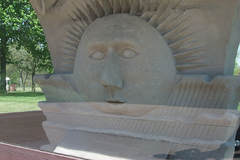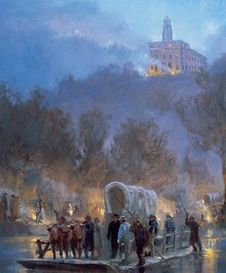
Soon after leaving Kirkland in 1839, the Lord commanded the Saints to “build a house to my name, for the Most High to dwell therein.” Obeying the command, Joseph Smith engaged William Weeks to design the Lord's house. With a 128 by 88 foot floor plan and towering 165 feet, the Nauvoo temple would be 60% larger than Kirkland’s. Weeks designed a Greek revival style building and under Smith’s direction incorporated motifs of Sunstones, Moonstones, and Starstones. The motifs represented the Church, the bride, and the lamb's wife as described in Revelation 12:1 "a woman clothed with the sun, and the moon under her feet, and upon her head a crown of twelve stars.”

William Weeks was born 13 March 1813 on Martha’s Vineyard. He learned his building and architectural skills from his father who was a builder, too. Weeks left the island as a young adult and converted from Quakerism to Mormonism while in the southeast. He was in Missouri and driven east in the winter 1838. On 11 June 1839 in Quincy, Illinois, he married Caroline Matilda Allen and eventually traveled to Nauvoo to begin his design. On 6 April 1841, Joseph Smith laid the cornerstone for the temple.
The temple had a full basement, which was used as the baptistery. The arched stone pillars supported the floor above and formed six rooms on either side. The flooring was herringbone-patterned in brick and sloped toward the center for drainage. The fire red flooring and the angel white walls created a dramatic contrast to the cavernous room. Dominating the center was a sixteen by twelve foot limestone baptismal font supported by twelve life-size oxen crafted from pine. A staircase, centered between the oxen, rose seven feet to the font’s rim.
The temple had a full basement, which was used as the baptistery. The arched stone pillars supported the floor above and formed six rooms on either side. The flooring was herringbone-patterned in brick and sloped toward the center for drainage. The fire red flooring and the angel white walls created a dramatic contrast to the cavernous room. Dominating the center was a sixteen by twelve foot limestone baptismal font supported by twelve life-size oxen crafted from pine. A staircase, centered between the oxen, rose seven feet to the font’s rim.

The temple was half completed when Joseph Smith was assassinated in a Carthage jail cell on 27 June 1844. The Saints survived the succession crisis that ensued until Brigham Young was chosen to lead them. As mob violence increased around Nauvoo, Brigham urged the Saints to complete the temple while still planning the exodus west. In October 1845, Brigham dedicated the nearly completed temple. Soon after, the Saints began receiving their ordinances. Brigham wrote in his diary in January 1846 that he worked twenty hours a day for a fortnight rendering endowments and marriage sealings. On 15 February 1846, he left Nauvoo; the exodus was underway. A once teeming city would soon become a shadow of its former self.
On 9 October 1848, a fire destroyed much of the temple. Two years later, a tornado flattened two of the standing walls, and by 1857, the temple was completely razed. Joseph Smith’s beacon of hope was now open land on a promontory overlooking the Mississippi, seemingly lost to the ages. But in 1999, The Church announced plans to rebuild the temple on its original footprint. Two years later it was dedicated and today, especially at nightfall, it is a beacon to be witness for miles around.
In The Believers, Naamah attended the Temple’s dedication in October 1845. Below is a portion her day.
______________________________________________________________
Inside and amazed by the temple’s magnitude, Naamah moved with head up, feeling dwarfed. She stepped from the propelling crowd to turn slowly and take in more. Light streamed in to enchant her and to create a warm ambiance. She inhaled, and her awe gave way to admiration. Joseph’s vision has finally come to pass.
Four years earlier, Joseph broke ground for the temple. As Prophet, he decreed neither sacred endowments nor general conferences would occur until the temple was completed. While finishing details were still needed, the windows were in place, the flooring had been laid, and seating was adequate to accommodate the congregation.
Naamah sat next to Amelia and among sisters, many of whom were from Peterborough. As usual recently, Aunt Susan was not near, so Naamah scanned hoping to spot her. She ceased when President Young arose and the clamor quieted.
He moved like a lion surveying his domain. When Naamah clutched Amelia’s forearm, she twitched and turned to Naamah with a quizzical look. Naamah forced a meek smile and released her grip. A hush came.
Brigham bowed his head and uttered inaudible words before slowly raising it while tightening his podium grip. With a roar powerful enough to rattle the windows he said, “Lord, today we dedicate this house.” He flung his arms toward the heavens, “We dedicate this monument of the Saints, and we dedicate ourselves unto thee.” He paused as amen followed.
As he continued, Naamah was riveted. When he paused for a moment, she surveyed the sisters around her. They were captivated, too. She turned to the podium and thought, Such a powerful man, and a mere step from the Prophet. She glanced at Amelia and thought of her earlier comment. Being near him, like Sister Emily, does have advantages, she thought.
Brigham opened his arms and raised them skyward “On this Sabbath, I hereby decree the temple’s motto for eternity to be,” and he paused before roaring, “holiness unto the Lord.”
As he strode from the podium, Naamah sensed her cheeks had flushed. She placed her right hand near her bosom, an instinctive effort to quell a fluttering heart. Amen, President Young, amen. She was unsure if she said it aloud or whether it arose out of her soul.
Others speakers followed, but lacking Brigham’s vigor, Naamah’s attention waned. Her eyes drifted, hoping to spot Aunt Susan. Her search became methodical as her hopes faded into worry. I pray the killing frost kills her ague, too.
Elder John Taylor, still with the musket ball in his left knee that he received during the martyrdom fifteen months earlier, limped toward the podium. He appeared sage-like with a thick mane of greying, unruly hair that extended into his sideburns to mask his ears. He clutched the podium, but unlike President Young, to steady himself. As he talked about the Saints completing the temple and leaving in the spring, Naamah thought, I pray Aunt Susan will be among us. She continued to wonder about the exodus until Taylor elevated his voice and stood erect.
With fists clenched and renewed vigor, Taylor said, “I shall rejoice on the day we are beyond the bounds of these so-called Christians.” He patted the lump in his coat pocket and smiled broadly as his eyes opened farther, seemingly in delight. “For then, I will need not my six-shooter to fend against those blood suckers who tried in vain to drain life from me in that Carthage Jail.”
“Amen,” roared the crowd in unison.
______________________________________________________________
Inside and amazed by the temple’s magnitude, Naamah moved with head up, feeling dwarfed. She stepped from the propelling crowd to turn slowly and take in more. Light streamed in to enchant her and to create a warm ambiance. She inhaled, and her awe gave way to admiration. Joseph’s vision has finally come to pass.
Four years earlier, Joseph broke ground for the temple. As Prophet, he decreed neither sacred endowments nor general conferences would occur until the temple was completed. While finishing details were still needed, the windows were in place, the flooring had been laid, and seating was adequate to accommodate the congregation.
Naamah sat next to Amelia and among sisters, many of whom were from Peterborough. As usual recently, Aunt Susan was not near, so Naamah scanned hoping to spot her. She ceased when President Young arose and the clamor quieted.
He moved like a lion surveying his domain. When Naamah clutched Amelia’s forearm, she twitched and turned to Naamah with a quizzical look. Naamah forced a meek smile and released her grip. A hush came.
Brigham bowed his head and uttered inaudible words before slowly raising it while tightening his podium grip. With a roar powerful enough to rattle the windows he said, “Lord, today we dedicate this house.” He flung his arms toward the heavens, “We dedicate this monument of the Saints, and we dedicate ourselves unto thee.” He paused as amen followed.
As he continued, Naamah was riveted. When he paused for a moment, she surveyed the sisters around her. They were captivated, too. She turned to the podium and thought, Such a powerful man, and a mere step from the Prophet. She glanced at Amelia and thought of her earlier comment. Being near him, like Sister Emily, does have advantages, she thought.
Brigham opened his arms and raised them skyward “On this Sabbath, I hereby decree the temple’s motto for eternity to be,” and he paused before roaring, “holiness unto the Lord.”
As he strode from the podium, Naamah sensed her cheeks had flushed. She placed her right hand near her bosom, an instinctive effort to quell a fluttering heart. Amen, President Young, amen. She was unsure if she said it aloud or whether it arose out of her soul.
Others speakers followed, but lacking Brigham’s vigor, Naamah’s attention waned. Her eyes drifted, hoping to spot Aunt Susan. Her search became methodical as her hopes faded into worry. I pray the killing frost kills her ague, too.
Elder John Taylor, still with the musket ball in his left knee that he received during the martyrdom fifteen months earlier, limped toward the podium. He appeared sage-like with a thick mane of greying, unruly hair that extended into his sideburns to mask his ears. He clutched the podium, but unlike President Young, to steady himself. As he talked about the Saints completing the temple and leaving in the spring, Naamah thought, I pray Aunt Susan will be among us. She continued to wonder about the exodus until Taylor elevated his voice and stood erect.
With fists clenched and renewed vigor, Taylor said, “I shall rejoice on the day we are beyond the bounds of these so-called Christians.” He patted the lump in his coat pocket and smiled broadly as his eyes opened farther, seemingly in delight. “For then, I will need not my six-shooter to fend against those blood suckers who tried in vain to drain life from me in that Carthage Jail.”
“Amen,” roared the crowd in unison.


 RSS Feed
RSS Feed
